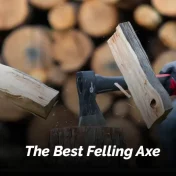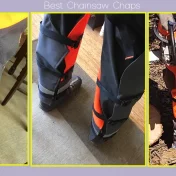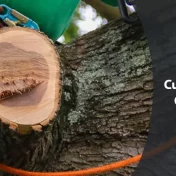Tree climbing is an art as much as it is a science. For arborists, the right equipment is paramount, not just for efficiency, but for safety.
One of the most crucial pieces of equipment in an arborist’s arsenal is the tree climbing rope.
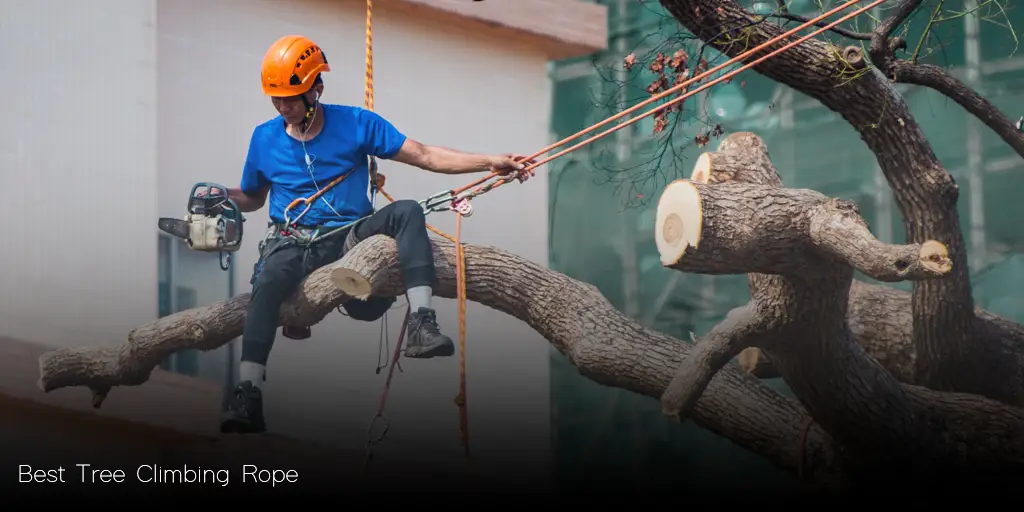
Choosing the best tree climbing rope is not a matter of preference alone; it’s a decision that can impact the safety and efficiency of a climb.
This guide dives deep into the world of tree climbing ropes, from their historical significance to the modern-day varieties that arborists swear by.
There are a plethora of rope types available in the market, each tailored to specific needs and applications. But how do you decide which is the best fit for you?
Whether you’re a seasoned tree care professional or a budding enthusiast, understanding the nuances of each rope type can be a game-changer. In this guide, we’ll explore:
- The rich history of tree climbing ropes and their evolution.
- The foundational knowledge about rope materials and construction.
- Crucial factors that should influence your rope choice.
- And much more!
So, let’s embark on this journey and uncover the secrets behind the best tree climbing ropes available today.
For those in a hurry, here’s a quick comparison of the 5 best tree climbing ropes based on user reviews and expert opinions:
History of Tree Climbing Ropes
The history of tree climbing ropes is intertwined with the evolution of arboriculture and the ever-growing need for safer and more efficient tools in the field.
Trees have always played a significant role in human history, whether for shelter, food, or spiritual significance. As our understanding and interaction with trees evolved, so did the tools and techniques used to climb them.
Ancient Beginnings
Long before the invention of specialized tree climbing ropes, early civilizations utilized natural fibers like hemp, sisal, and jute to craft rudimentary ropes.
These ropes, while not as durable or safe as modern counterparts, served the purpose for simple tree climbing tasks.
- Hemp Ropes: Renowned for their strength and flexibility, hemp ropes were widely used in ancient China and Europe. They were often soaked in water to enhance their durability during climbs.
- Sisal Ropes: Native to Central America, sisal provided a robust and rot-resistant alternative to hemp. Its fibers were used by indigenous communities for various applications, including tree climbing.
The Modern Evolution
The 20th century heralded significant advancements in rope-making technologies. With the introduction of synthetic materials like nylon and polyester, ropes became more durable, elastic, and resistant to environmental factors.
- Nylon Ropes: Introduced in the 1930s, nylon ropes revolutionized tree climbing. They offered superior strength, elasticity, and resistance to moisture compared to natural fibers.
- Polyester and Polypropylene: These materials further enhanced rope durability and reduced weight, making tree climbing more efficient and safer.
Today, tree climbing ropes are a blend of tradition and technology, with arborists having a plethora of options tailored to specific needs and applications.
Whether it’s the traditional 3-strand rope or the modern kernmantle design, each has its unique history and contribution to the world of arboriculture.
Understanding Rope Basics
To truly appreciate the intricacies of tree climbing ropes, one must grasp the fundamental aspects that dictate their performance, durability, and safety. This section provides a deep dive into the materials used in ropes and their construction techniques.
Materials Used in Ropes
Different materials lend ropes their unique characteristics, and understanding them is crucial in selecting the best tree climbing rope for specific tasks.
Natural Fibers:
- Hemp: Historically popular, it offers good strength but can be susceptible to rot and moisture.
- Sisal: Durable and rot-resistant but lacks the elasticity of synthetic ropes.
- Jute: Often used for decorative purposes today, it was once a staple in rope-making.
Synthetic Fibers:
- Nylon: Known for its high strength, elasticity, and resistance to moisture.
- Polyester: Provides excellent UV resistance and minimal stretch, ideal for specific climbing tasks.
- Polypropylene: Lightweight and floats on water but is less durable than nylon or polyester.
Rope Construction and Types
The way a rope is constructed significantly influences its behavior during climbs. Let’s explore some common rope constructions:
- 3-Strand Rope: A traditional design where three strands are twisted together. It’s known for its durability and shock absorption but can be bulkier and less smooth than other types.
- Braided Rope: Made by braiding fibers together, this design provides a smooth surface, reducing friction and enhancing maneuverability during climbs.
- Kernmantle Rope: A modern favorite among arborists, kernmantle ropes consist of a protective outer sheath (kern) and an inner core (mantle) that provides strength. This design offers a balance between durability, flexibility, and safety.
- Rope Sizing: Diameter and length play a crucial role in a rope’s performance. While thicker ropes offer more strength, they can be heavier and harder to handle. It’s essential to strike a balance based on the task at hand.
By understanding the materials and construction techniques, arborists can make informed decisions, ensuring that their rope is not just a tool but an extension of their skill and expertise.
Factors to Consider When Choosing the Best Tree Climbing Rope
Selecting the best tree climbing rope is not merely about picking the most expensive or the most popular option. Several factors influence the performance, safety, and longevity of a rope.
Let’s delve deep into these considerations to ensure you make the right choice.
Strength and Durability
At the forefront of considerations is the strength and durability of the rope:
- Tensile Strength: Refers to the maximum load a rope can handle without breaking. Always opt for ropes that surpass the minimum required strength for your tasks.
- Wear Resistance: A rope’s resistance to abrasion and environmental factors like UV rays determines its lifespan. Ropes with protective sheaths or treatments can offer enhanced durability.
Flexibility and Elasticity
A rope’s behavior during climbs is influenced by its flexibility and elasticity:
- Static Ropes: These have minimal stretch, making them ideal for tasks where precise positioning is needed, such as rigging.
- Dynamic Ropes: They stretch more under load, providing shock absorption, especially during falls.
Rope Diameter and Sizing
Size matters when it comes to ropes:
- Thicker Ropes (e.g., 12mm): Offer higher strength but can be bulkier and harder to handle.
- Thinner Ropes (e.g., 10mm): Provide adequate strength for most tasks and are easier to maneuver. However, they might wear out faster.
Safety Ratings and Certifications
Always prioritize safety:
- Certifications: Look for ropes that meet industry standards, such as those set by the International Climbing and Mountaineering Federation (UIAA) or the European Committee for Standardization (EN).
- Load Ratings: Ensure the rope can handle the maximum anticipated load, including the climber, equipment, and any external forces.
Making an informed decision based on these factors ensures not just a successful climb but also the safety and well-being of the climber.
Remember, the best tree climbing rope is one that aligns perfectly with your needs and the demands of the task at hand.
Tree Climbing Rope vs. Rigging Rope
In the realm of arboriculture, understanding the distinction between tree climbing ropes and rigging ropes is paramount.
Though they might seem similar to the untrained eye, their design, purpose, and characteristics can differ significantly.
Let’s explore these differences and understand when to use each type.
Purpose and Application
Tree Climbing Ropes:
- Specifically designed to support the weight of a climber.
- Must provide a balance between strength, flexibility, and maneuverability.
- Used primarily for ascending, descending, and moving around the tree canopy.
Rigging Ropes:
- Designed to handle the weight of tree sections being removed or heavy equipment.
- Prioritize strength and durability over flexibility.
- Used for lowering branches, rigging equipment, and anchoring.
Design and Construction
While both types of ropes can be made from similar materials, their construction can vary based on their intended use:
Tree Climbing Ropes:
- Often feature a smoother surface to reduce friction during climbs.
- Might have a more elastic design to absorb shocks and provide flexibility.
Rigging Ropes:
- Typically have a tougher, more abrasion-resistant design.
- Might be thicker and have higher tensile strength.
Safety Considerations
The safety requirements for these ropes differ based on their applications:
Tree Climbing Ropes:
- Should have a consistent diameter for grip.
- Must provide adequate stretch to prevent jarring stops during falls.
Rigging Ropes:
- Should have minimal stretch to ensure precise positioning of loads.
- Must be checked regularly for wear, especially if used to lower heavy loads.
In-Depth Look at Tree Climbing Rope Types
Arborists today are spoiled for choice when it comes to tree climbing ropes. Each type boasts its unique set of features, advantages, and ideal applications.
Let’s dive deep into some of the most popular tree climbing rope types, shedding light on their characteristics and best use-cases.
1. Samson Arbor-Plex Climbing Rope
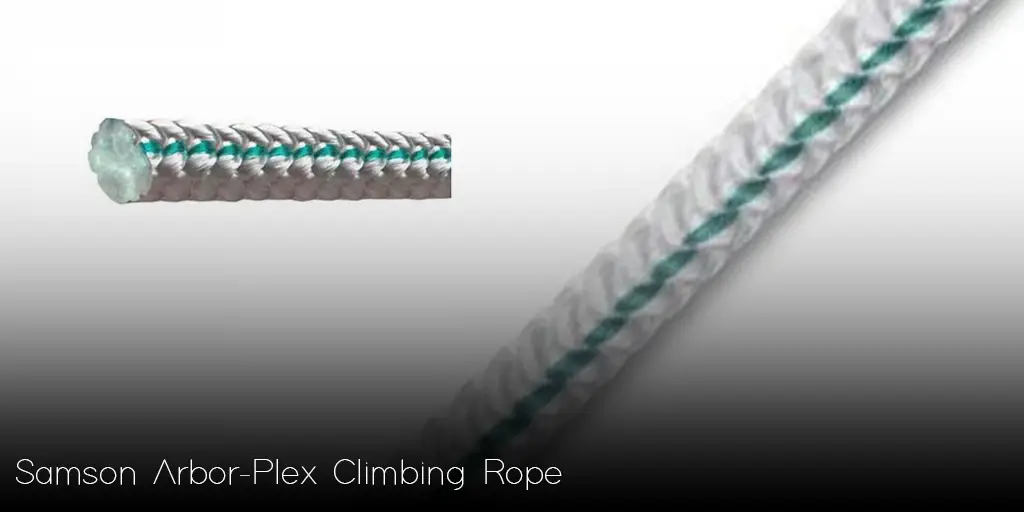
When it comes to finding the Best Tree Climbing Rope, the Samson Arbor-Plex Climbing Rope stands out as a top contender.
This 12-strand climbing rope, measuring 1/2 inches in diameter and 120 feet in length, is designed to offer the best in performance versus price for a modern tree climber’s safety line.
Pros:
- High-Quality Construction: Made with a Dura-tite construction of 12 strands of polyester and polyolefin fibers, ensuring durability and longevity.
- Knot Control: The Dura-tite process tightens the braid, keeping the rope round and firm, which is essential for knot control.
- Snag Resistance: The rope is designed to be resistant to snags, which is crucial when climbing trees with rough surfaces.
- Extended Lifespan: The exterior polyester fibers have a parallel fiber orientation, minimizing the sawing action of the rope on rough surfaces, thus prolonging its life.
Cons:
- Slight Stretch: Some users might find the slight stretch in the rope (3.15% ABS elongation at 540 lbs) to be a disadvantage, especially if they’re used to ropes with no give.
Specifications:
- Material: Polyester and Polyolefin
- Length: 120 feet
- Diameter: 1/2 inch
- Construction: 12-strand Dura-tite
- Elongation: 3.15% ABS at 540 lbs
2. Samson True Blue Climbing Rope
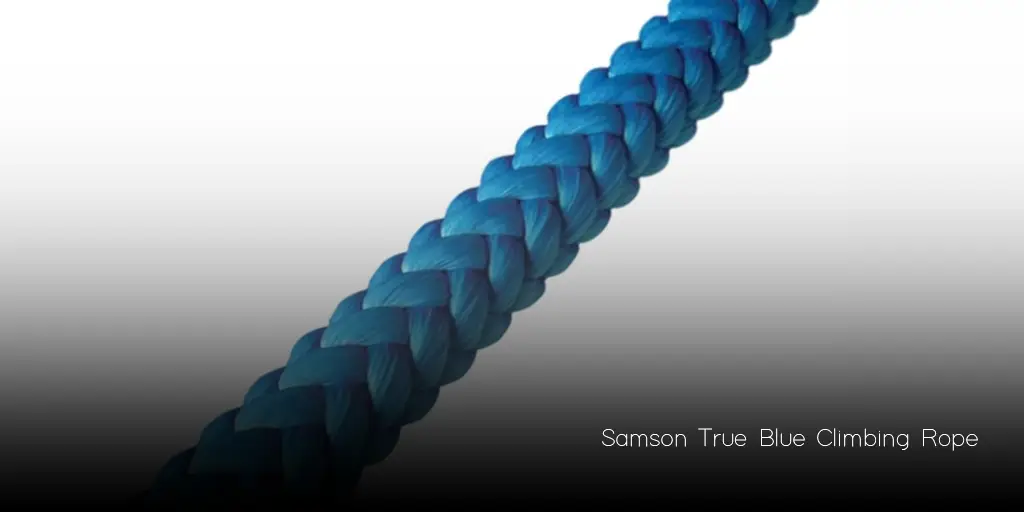
The Best Tree Climbing Rope is a title many ropes vie for, and the Samson True Blue Climbing Rope is undeniably a strong contender.
With its unique construction and design, this rope promises both durability and performance.
Pros:
- Unique Construction: The True-Blue braided climbing rope boasts a combination of extrusion set blue polyester fibers wrapped over a white polyester core.
- Durable: With a 12-strand dura-tite braid, this rope is built to last.
- High Tensile Strength: The rope can handle a tensile strength of 7,300 lbs. (32.5 kN), ensuring safety during climbs.
- Weight: Weighing 8.8 lbs per 100 ft., it strikes a balance between heft and maneuverability.
Cons:
- Knotting Issues: Some users have reported that the rope tends to knot by itself, which can be a minor inconvenience during climbs.
Specifications:
- Material: Polyester
- Color: Mixed
- Diameter: 1/2″ (13mm)
- Weight: 8.8 lbs per 100 ft.
- Tensile Strength: 7,300 lbs. (32.5 kN)
- Length: 120 Feet Hank
3. 12 Strand Arborist Climbing Blue Ox Rope
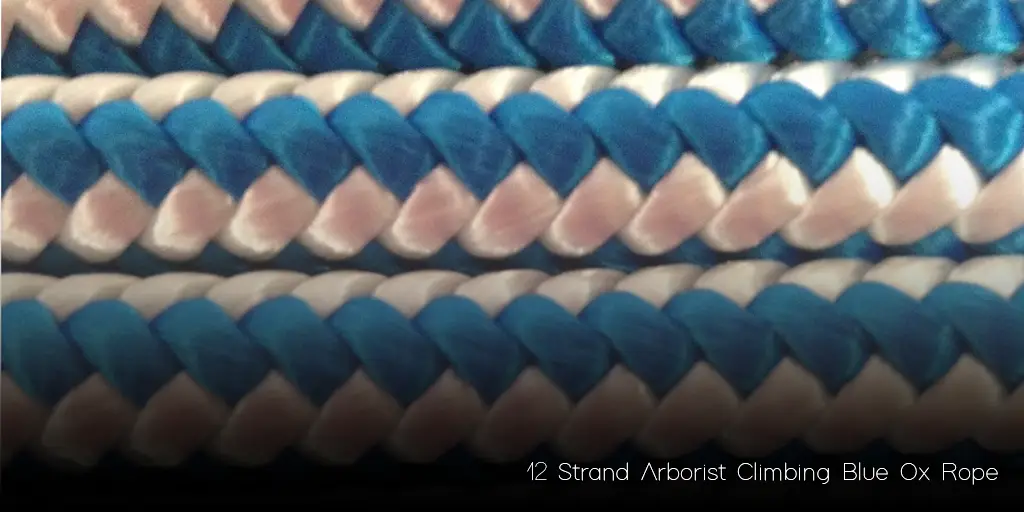
For those on the hunt for the Best Tree Climbing Rope, the 12 Strand Arborist Climbing Blue Ox Rope is a noteworthy option.
This rope, measuring 1/2 inch by 150 feet, is designed with the arborist in mind, ensuring safety and efficiency during climbs.
Pros:
- High Tensile Strength: With a tensile strength of about 8,000 pounds, this rope promises durability and reliability.
- Arborist-Friendly: Specifically designed for tree climbing, ensuring optimal performance.
- Abrasion Resistance: The rope is highly resistant to hand abrasion, milking, and sunlight, ensuring longevity.
- Flexibility: The rope is flexible, ensuring good knot retention, which is crucial during climbs.
- Material: Made of 12-strand polyester, it provides a balance between strength and flexibility.
Cons:
- No Splicing: The rope does not come pre-spliced, which might be a minor inconvenience for some users.
Specifications:
- Material: Polyester
- Color: Blue and White
- Brand: Blue Ox Rope
- Style: Classic
- Line Weight: 8,000 pound
- Length: 150 Feet
- Tensile Strength: 8,000 Pounds
4. Samson Arbormaster Blue Streak 16 Strand Climbing Rope
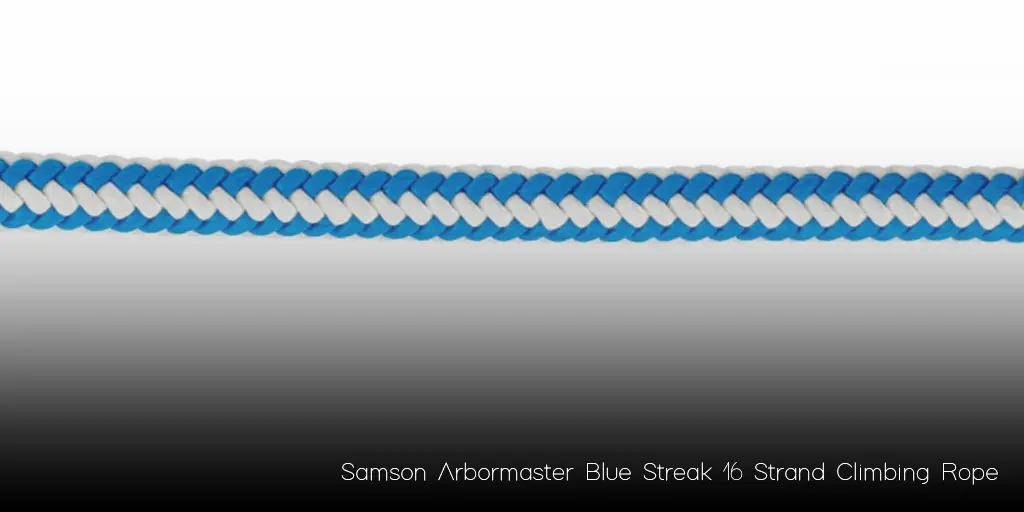
For those in pursuit of the Best Tree Climbing Rope, the Samson Arbormaster Blue Streak 16 Strand Climbing Rope is a standout choice.
This rope, with its distinctive blue streak design, is tailored for the modern arborist, ensuring a blend of durability and performance.
Pros:
- Durability: The rope offers maximum firmness suitable for all climbing techniques.
- Easy Grip: The 1/2-inch (13 mm) diameter ensures a comfortable grip, essential for tree climbing.
- Low Stretch: With an elongation of 2.2% at 540 lbs., climbers can expect minimal stretch, enhancing safety.
- Knot-Heat Resistance: The rope exhibits excellent knot-heat resistance, a crucial feature for maintaining knot integrity during climbs.
- High Visibility: The polyester cover with high visibility ensures climbers can easily spot the rope even in dense foliage.
Cons:
- Surface Feel: Some users have mentioned the rope has a slick feel, which might require mechanical aid for ascending if one were to fall.
Specifications:
- Material: Nylon core and polyester cover
- Color: Blue Streak
- Diameter: 1/2″ (13 mm)
- Construction: 16 strand Class I rope
- Length: 150 Feet Hank
- Elongation: 2.2% at 540 lbs.
5. Yale XTC Fire Climbing Rope
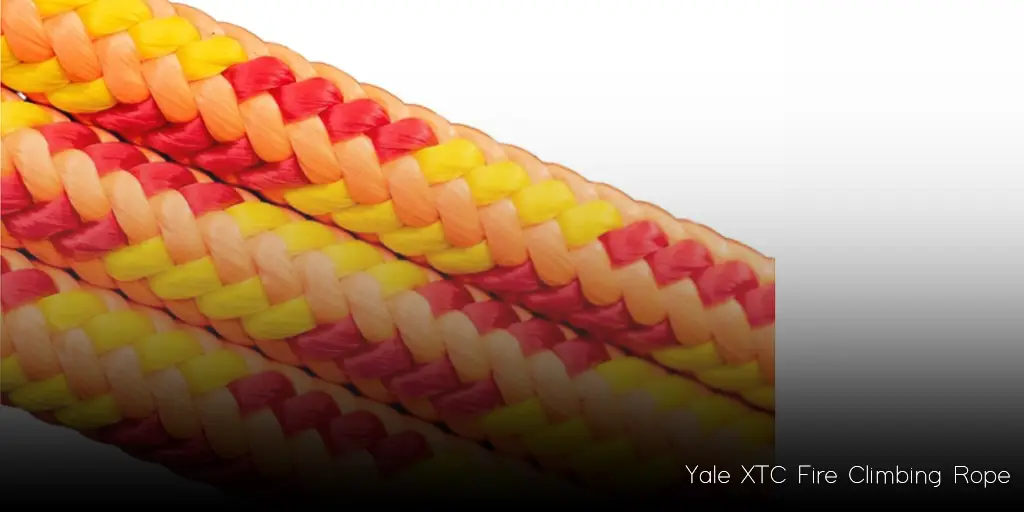
For those who prioritize quality and performance in their search for the Best Tree Climbing Rope, the Yale Cordage XTC-16 Arborist Climbing Rope is a top-tier choice.
This rope, with its vibrant “Fire” color, is not only visually appealing but also packs a punch in terms of features and durability.
Pros:
- High-Quality: Made in the USA, ensuring top-notch craftsmanship and quality.
- Strong Tensile Strength: Boasting a tensile strength of 6200 LB, this rope promises safety and reliability.
- Durable Construction: The 16-strand polyester construction ensures durability and longevity.
- High Visibility: The “Fire” color ensures the rope stands out, making it easy to spot during climbs.
- Tight Braid: The tightest cover braid in the industry ensures minimal wear and tear.
Cons:
- Price: Some users might find the price a bit steep, but the quality justifies the cost.
Specifications:
- Material: Polyester
- Color: Fire
- Diameter: 1/2″ (13 mm)
- Construction: 16 strand polyester
- Tensile Strength: 6200 LB
- Working Load Limit: 620 LB (Do not exceed)
- Length Options: Available in 100, 120, 150, and 200 feet.
Safety Tips and Precautions
Arboriculture, while rewarding, comes with its fair share of risks. The right equipment, combined with knowledge and precautions, can make tree climbing a safe endeavor.
Given the pivotal role tree climbing ropes play in ensuring safety, let’s explore some vital tips and precautions associated with their use.
Proper Usage of Tree Climbing Ropes
- Regular Inspection: Before each use, inspect your rope for signs of wear, damage, or fraying. A compromised rope can jeopardize safety.
- Avoid Sharp Edges: Ensure that the rope doesn’t come in contact with sharp tree branches or edges that can cause abrasion.
- Use Compatible Equipment: Always pair your rope with compatible climbing gear, such as carabiners and harnesses, to ensure optimal performance and safety.
Maintenance and Inspection Routines
- Clean Regularly: Dirt and debris can degrade the rope’s fibers. Clean your rope with mild soap and water, and let it dry naturally.
- Store Properly: Store ropes in a cool, dry place away from direct sunlight. UV rays can weaken synthetic ropes.
- Check for Knots: Before and after use, ensure that there are no unintended knots in the rope, as knots can reduce its strength.
Common Mistakes to Avoid
- Avoid Overloading: Never exceed the rope’s recommended weight limit.
- Steer Clear of Chemicals: Harsh chemicals can degrade the rope’s material, reducing its lifespan and safety.
- Don’t Ignore Wear Signs: If a rope shows significant signs of wear or has been subjected to a heavy load or fall, consider replacing it.
Safety, in essence, is a combination of the right equipment, proper knowledge, and a vigilant approach.
While the best tree climbing rope can provide a foundation, it’s the climber’s responsibility to ensure it’s used correctly and safely.
You May Also Enjoy Reading:
- How to Cut Tree Limbs Over House
- How to Cut a Leaning Tree in the Opposite Direction
- Best Ripping Chain for Milling (Top 5 Picks)
Maintenance, Care, and Longevity
Investing in a high-quality tree climbing rope is only half the battle. Ensuring its longevity, performance, and safety over time requires regular maintenance and care.
Here’s a comprehensive guide to keeping your rope in peak condition.
Cleaning Your Rope
Dirt, sap, and other contaminants can compromise the integrity and performance of a rope. Here’s how to keep it clean:
- Routine Dusting: After each use, shake out your rope to remove loose dirt and debris.
- Washing: For a deeper clean, soak the rope in lukewarm water with a mild detergent. Gently agitate, rinse thoroughly, and allow it to air dry away from direct sunlight.
- Avoid Harsh Chemicals: Steer clear of bleach or other aggressive chemicals that can degrade rope fibers.
Storage Tips
Proper storage can significantly extend the lifespan of your rope:
- Cool, Dry Place: Store your rope in a location away from moisture and direct sunlight. Both can weaken the rope over time.
- Loosely Coiled: Avoid tight coils or kinks, which can strain the rope fibers. Store in a bag or hang it loosely.
- Keep Away from Pests: Ensure the storage area is free from rodents, which can chew through the rope.
Regular Inspection
A routine inspection can identify potential issues before they become significant hazards:
- Check for Abrasions: Look for any signs of external wear or damage.
- Test Flexibility: A rope that has become stiff or brittle may be compromised.
- Inspect for Discoloration: Any unusual color changes, especially in synthetic ropes, might indicate UV damage or chemical exposure.
Remember, a well-maintained rope not only ensures safety but also provides consistent performance and reduces long-term costs. Dedicate time to care for your rope, and it will serve you reliably for years to come.
FAQs on Tree Climbing Ropes
Over the years, arborists and enthusiasts alike have raised numerous questions about tree climbing ropes. This section aims to address some of the most common queries, providing clarity and insights.
How often should I replace my tree climbing rope?
The lifespan of a tree climbing rope varies based on its usage, maintenance, and exposure to environmental factors. As a rule of thumb, replace your rope if it shows significant signs of wear, has been subjected to a heavy load or fall, or if it’s over a certain age, typically 5-10 years.
Can I use any rope for tree climbing?
No, always use ropes specifically designed for tree climbing. These ropes are constructed to handle the demands and safety requirements of arboriculture.
How do I know if my rope is damaged?
Regularly inspect your rope for signs of abrasion, cuts, fraying, discoloration, or stiffness. Any of these signs could indicate damage or wear.
Are synthetic ropes better than natural fiber ropes?
Synthetic ropes, like nylon or polyester, offer advantages like higher strength, elasticity, and resistance to environmental factors. However, the “best” rope depends on the specific requirements of your task.
How do I clean and store my rope to ensure longevity?
Clean your rope using lukewarm water and mild detergent, allowing it to air dry away from direct sunlight. Store it in a cool, dry place, coiled loosely to avoid kinks or strain.
By addressing these FAQs, arborists and tree climbing enthusiasts can make informed decisions and ensure their safety and efficiency during climbs.
Conclusion
The world of arboriculture is both challenging and rewarding. At its core lies the importance of safety, expertise, and the right equipment.
The tree climbing rope, often overlooked, is the lifeline of every arborist. It’s not just a tool but a testament to the climber’s commitment to their craft and safety.
From understanding the rich history of ropes to discerning the nuances of modern materials and constructions, we’ve journeyed through the intricate world of tree climbing ropes.
The choices might seem overwhelming, but equipped with knowledge, every arborist can find their perfect rope match.
Remember, the best tree climbing rope is not just the most expensive or popular one. It’s the rope that aligns with your needs, ensures your safety, and stands the test of time with proper care and maintenance.
As you ascend the lofty heights, let your rope be a trusted companion, ensuring every climb is both successful and safe. Here’s to many more climbs and the endless pursuit of arboricultural excellence!





